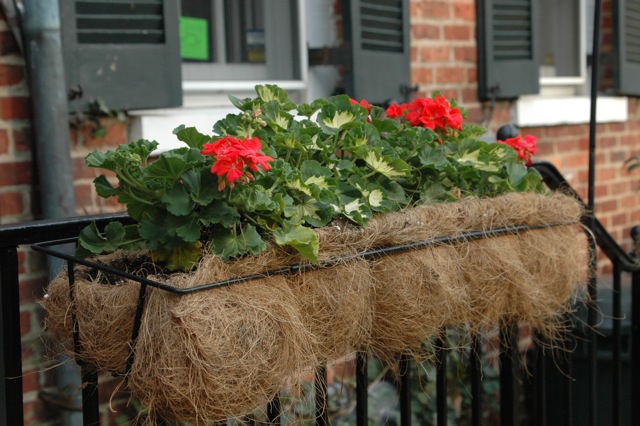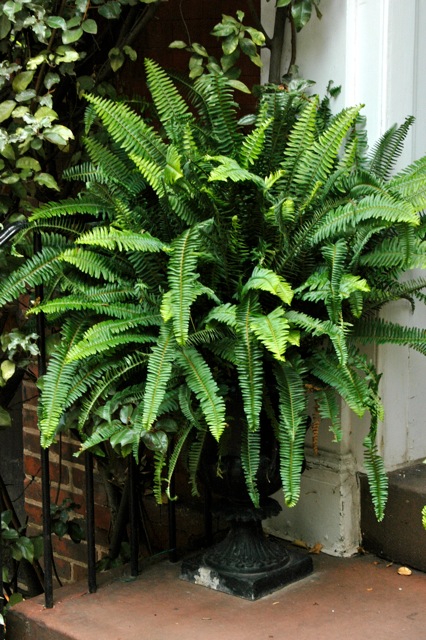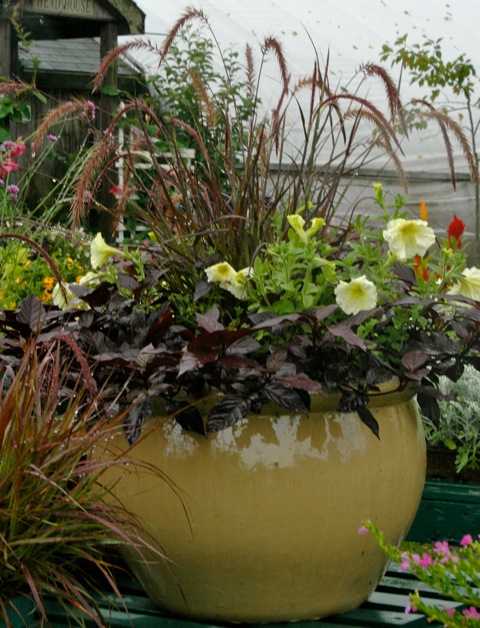Just say “yes” to pot(s)

The fog has rolled in, here on the coast of Maine. I’ve been repeatedly told there was hardly any fog in July or the first part of August when I was sweating uncomfortably in our Nation’s Capitol, but now I’m here fog has apparently resumed its usual place in the coast weather pattern. I am making every effort not to take it personally.

Instead, I am making the best of it by acting on a thought I’ve had every spring when I’m trying to decide what to plant in my pots. That is, I’m making notes and taking photos now of especially sumptuous pots. That way, next year I have an idea of what I want to have before I walk into my favorite nurseries and am stricken with “kid in a candy shop” syndrome when facing benches of gorgeous annuals.

Potted plants, annuals in particular, are an important feature in small gardens and especially in Washington where summer’s heat drains color from perennials and flowering shrubs, and shortens their bloom times. Annuals growing in well placed pots can keep the magic of color, fragrance, and texture going well into fall, especially if they are pinched, fertilized, and watered regularly.
Some of my favorite pots this summer have featured a single type of annual. I especially love a profusion of yellow daisies but they can get ragged in Washington’s heat. A great alternative is yellow lantana (Lantana camara) for its heat, sun, and drought tolerance and its lemony fragrance. Lantanas also come in pink, orange, white, and lavender, attract butterflies, and combine well with other sun-loving annuals. Their berries are said to be toxic, though, so it’s best to snip them if you have dogs or small children. Removing the berries, of course, will also encourage new blooms.

For shade I love impatiens, both combined with other plants or not. It’s really hard to beat such a great workhorse, though my snooty designer friends look down their noses at me for confessing admiration of such a commoner. Brightly colored begonias and delicate fuchsias are terrific, but seem to bloom less vigorously in deep shade where ferns thrive. Simple ferns, especially planted in black, old-fashioned urns are completely elegant. There’s something languid, cool, and constant about well-tended ferns.
Pots of mixed plants are trickier. First, you have to combine plants that require similar growing conditions and have compatible or complimentary growth habits. Next, their colors should match. This seems obvious, but I have had to avert my eyes more than once at color combinations that remind me of Bozo the Clown’s sartorial choices. One need not be uptight about color combinations, but a little can go a long way.

A strong simple color combination I must keep in mind next year is pale lemon yellow and burgundy, like pale yellow petunias, purple fountain grass (Penasetum alopecoroides) for height, and Alternanthera dentata 'Royal Tapestry', all of which like sun and can stand some shade. On the other hand, a good purple flower can stand out cheerfully against chartreuse. One wouldn’t want to plop this combination near orange flowers, though inexplicably I have seen it done. I adore blue flowers, but avoid lobelias because I can’t grow them to save my life, love them as I do. Instead, I have had great success with blue fan flower (scaevola aemula). This Australian native tolerates light shade as well as full sun and is used as a ground cover in warmer zones where it is hardy. I love it with dark purple petunias, peach trailing verbena (Verbena speciosa), and white geraniums; with fuzzy Swedish Ivy (Plectranthusforsteri “Marginatus”), white verbena and light green flowering tobacco (nicotiana); or combined red petunias, purple fountain grass, and white bacopa for that “Fourth of July” celebration. The possibilities are almost endless.

Fillers are essential to well planted pots. By fillers I mean plants that you include more for foliage and/or form rather than for their flowers. Fillers have many uses. First, their structure can make or break a composition. For example, it’s almost always lovely to have something viney spilling luxuriously and softly down the sides of a container like ivy, sweet potato vine, or licorice plant (helichrysum). Unattractive containers, like window boxes with shaggy coco-liners that resemble badly tended facial hair, absolutely require the cloak of an obscuring filler. Second, if you are not assiduous in pinching back your blooming plants or if you inadvertantly missed watering opportunities and your annuals have temporarily gone leggy or stopped blooming, fillers with good foliage tend to compensate in the color and texture department until the bloomers recover. Third, fillers offer subtle contrast that flowering plants usually lack.

I tried chartreuse sweet potato vine this summer with great trepidation and the encouragement of an old nursery hand. After a couple of months I decided that I liked it because it beautifully softened the brick planter it was in. Next summer I think I’ll be wild and experiment with burgundy-leafed plants of which there are several. In addition to Coleus “Dark Star”, an upright plant that has inch-long velvety leaves, and the good old purple sweet potato vine, I am very interested in “Purple Shield (Strobialanthus dyerianus). This old-fashioned plant dates back to Victorian gardening but we won’t hold that against it. It is an upright plant with long pointy magenta leaves marked strongly with complex dark green venation. It tolerates drought well and grows tall if not pinched back but doesn’t really start growing in earnest until temperatures begin to climb. This is one of those plants I probably wouldn’t dare mess with but having seen it successfully planted with purple angelonia and dusty miller (Senecio cineraria), I think I could handle it. I’m sure it would be gorgeous with purple lantana, all kinds of petunias, pink salvias, and pink dahlias as well.
My last “note-to-self” for this piece is articulating what I will avoid next year: Pink impatiens in front of red brick, filler plants that reach aggressively outward in a tight seating spaces, zinnias, and poor use of fertilizer.
Now the fog has lifted and it’s time to pinch my petunias.





